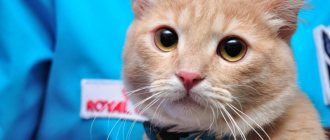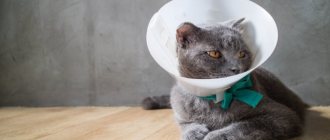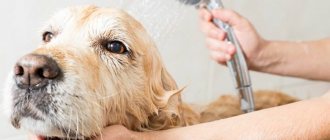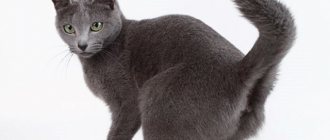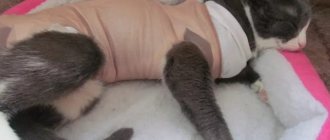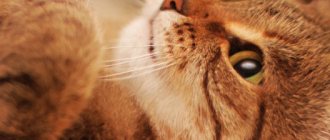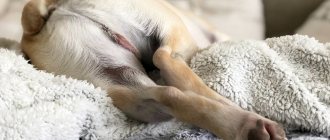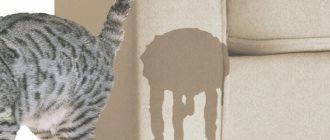Castration of a cat is the most common operation, around which the most conflicting opinions are multiplying. Owners fear that unexpected changes in the pet's character will appear or that castration will cause irreparable harm to health. Let's figure out how castration can affect a cat and whether you should worry.
The first hours after surgery
If the cat was castrated in a clinic, then the pet must spend the first hour there. This is the most difficult moment: the animal comes out of anesthesia, and the veterinarian must make sure that everything happens according to plan - no complications are observed.
The second and third hours spent at home are still quite difficult. The cat has general weakness and dizziness. He is most likely thirsty, but also feels nauseous. And what is most important to a pet now is the love and attention of its owner.
We recommend reading the article about the behavior of a cat after castration.
Key points to pay attention to at this time:
- Drying of the ocular conjunctiva. During the operation, the pet's eyes remain open. The doctor regularly moistens them using special drops. At home, this procedure should be done by the owner, placing tetracycline ointment or a special “Diamond Eyes” solution under the cat’s eyelids.
- Decrease in temperature. Most likely, at first it will remain at 37 °C, which is two degrees below normal. Your pet may experience mild tremors from time to time. Therefore, it is better to place it in a warm place and cover it with a blanket. As a last resort, you can use an electric heating pad in a case or a hot water bottle wrapped in a towel.
- Impaired coordination of movements. Due to high muscle weakness, when trying to stand up or walk, the cat may stagger from side to side. It is better to try to persuade him to lie down with gentle persuasion. This will pass in a couple of hours, now the main thing is to make sure that your pet does not fall, especially from a height.
- Refusal to eat. The cat is unlikely to develop an appetite in the first hours. Abstinence now is only good for him. Otherwise, vomiting may begin.
- Painful sensations. It is advisable to ask your doctor in advance what painkillers you can use. Signs that a pet is suffering may include dilated pupils, pursed paws, and aggression when attempting contact.
Rules of care, transportation and rehabilitation
Regardless of the reason that prompted the owners to castrate their pet, you will need time for subsequent care for the cat.
This includes:
- The immediate postoperative period, when the cat recovers from anesthesia and the effects of sedatives;
- Observation of the incision and treatment of sutures, if any;
- Continue to comply with the veterinarian’s instructions after the stitches are removed and the animal is fully restored.
When agreeing to an operation for medical reasons, when intervention is required to preserve the health and life of the pet, in addition to the standard set - monitoring the cat’s condition, treating the suture - one will have to carry out complex treatment along with the underlying disease.
Why is cat rehabilitation needed after castration?
First of all, the rehabilitation process is aimed at identifying and preventing possible complications. Under the influence of anesthesia, a cat's self-regulation is disrupted; the pet is in an unconscious state or semi-conscious, when it cannot control the functioning of the muscles, the excretory system, and does not orient itself in space.
Body temperature drops sharply, additional heating is required, plus anesthesia causes a strong feeling of thirst. For several hours after surgery, the animal should recover from the effects of the medications, preferably under your supervision, as disturbances in the excretory and respiratory systems may occur.
If the animal is taken home immediately after surgery, the owner should have the doctor's contact phone number in case the pet's health worsens.
Rehabilitation involves creating conditions for the favorable and speedy restoration of the animal’s health. Preventing hypothermia, timely treatment of the suture, and preventing wound licking will protect your pet from the need for additional drug treatment.
How to transport a cat after surgery?
The most reasonable option is carrying. This is convenient for both the owner and the animal. A flat bottom will provide a comfortable position for the body, and, therefore, will minimize the risk of touching the incision, pushing, or inadvertently squeezing the blood circulation in the limbs. The walls of the carrier will provide the animal with shelter from light and the flickering of foreign objects. Ideally, if the veterinary clinic is far from home, take the cat by car or call a taxi. Public transport in this case can become a source of additional stress.
- Be sure to lay a warm, hygroscopic fabric on the bottom. The bedding should provide warmth to the animal and, if necessary, absorb liquid - the cat may wet itself because it does not control the bladder;
- The cat needs to be covered with a warm diaper or towel to keep warm;
- Place a heating pad on the side of the animal, but at a distance from the surgical suture, so as not to provoke bleeding.
If it is possible and the top of the carrier can be removed, then when you bring it home, you can leave it in place, opening it for observation. Or carefully place it on a flat surface (ideally on the floor), ensuring there are no drafts and a source of heat.
To avoid all this, you can simply call a veterinarian at home, then you will not need all the above-described manipulations!
Treatment of the surgical wound
During the first two weeks, the surgical area must be inspected regularly and checked to avoid bleeding or infection of the wound.
During the first week, to speed up the healing of the stitches, they should be treated with hydrogen peroxide twice a day and smeared with a solution of brilliant green. Later you can use iodine. In case of the slightest redness, you can lubricate the surgical area with Levomekol.
To prevent the cat from injuring the operating area, it is better to put a special collar on him for the first days. Otherwise, as a result of licking, the seams may come apart.
It is better to do the operation in winter or autumn. During this period, the likelihood of wound infection is less. During the summer, your veterinarian will usually prescribe a course of antibiotics for at least five days.
How is the castration procedure performed?
- Six are removed from the surgical site.
- The skin of the scrotum is lubricated with iodine.
- The skin above the testes is cut.
- The vaginal ligaments are cut with scissors or a scalpel.
- The vaginal lining is removed.
- The testis is removed or a special thread is tied around the spermatic cord to form a knot and the vas deferens is amputated.
- The wound edges are treated with iodine.
- Identical actions are performed on the second organ.
- The edges of the operated tissues are not sutured because the recovery is fast.
Toilet
As soon as the cat begins to stand up, it is necessary to place a litter tray with low sides near the bed. It is better to add a filler (silica gel is better, it does not create dust and dirt) that is light in color, so that you can immediately see if there is bleeding or pus.
If this is necessary, then on the first day you can use special diapers for cats.
If the cat avoids the toilet in the first days, this is understandable. Firstly, he had hardly eaten or drunk anything yet. Secondly, he experiences pain and discomfort and delays this moment. As a last resort, you can give your pet a little Vaseline oil.
It’s also okay if the cat goes to the toilet in small portions. This is normal for the first days. Within a month everything should be back to normal. And, most importantly, the urine will no longer have a pungent odor.
Tray
It is natural to assume that a cat that has survived castration will find it very difficult to use the litter box at first. The need to climb into it and stretch the wound will cause attacks of pain and negative associations. You should not be angry with your pet if, after surgery, he empties his intestines and bladder in the wrong place for some time. In addition to the pain experienced, the cat may simply have poor orientation in space when recovering from anesthesia.
During recovery, the cat may temporarily refuse the tray due to inconvenience during use.
In addition, if you use natural crumbly litter for the tray, there is a high probability of dust and small particles getting into the cut areas of the skin, which can result in inflammation. Therefore, while the wound is healing, it is advisable to have as an alternative a tray with a grid that will not allow the pet to come into contact with the filler.
Urination
Infrequent emptying of the bladder after castration is completely natural. First, your pet has barely consumed any fluids or food in the past few hours. Secondly, urination is still a painful procedure for the animal, so it is in no hurry to do it.
Difficulty urinating should not bother owners in the first couple of days
Don't panic if you see traces of blood in your pet's urine. Drops of blood may leak from a healing wound. The urge returns gradually, and after a few days the cat usually returns to its natural state and uses the litter box without problems.
Loud meowing during urination and unsuccessful trips to the toilet should be a cause for concern and take the animal to the veterinarian.
If you wish, to avoid puddles throughout the house, you can try to dress your pet in diapers. However, cats do not always support this decision and resist. You can read below about how to choose a suitable diaper and put it on your cat.
Diapers for cats: application and cost
Cat nutrition after castration
In the first hours and days, due to the effects of anesthesia and pain, the cat will not have time to eat. The main thing is not to force your pet to eat, this will only irritate him once again. Clean and fresh water should always be nearby. As soon as the nausea passes, the cat will quench its thirst.
Soon your appetite will return and, most likely, it will be increased. Overeating should not be indulged. Changes in hormonal levels can easily lead to obesity and related diseases. But if the cat refuses to eat two days after the procedure, this is an alarming factor. You need to contact a veterinarian.
As for the diet, it is better to gradually switch to special food for neutered cats or preventive food to prevent urolithiasis. If your pet is on a natural diet, remove fish and any food excessively enriched with calcium, phosphorus, and magnesium from the daily diet.
Dry food causes acidification of urine, which is also a prevention of urolithiasis, so this diet should be preferred. But drinking should always be plentiful. Read more in the article on what to feed a neutered cat.
Pain reaction and how to deal with it
Many owners believe that an animal will necessarily experience severe pain after surgery, but this is not entirely true.
- If your pet was neutered under local anesthesia, he is most likely young enough, and his metabolic rate is so high that the pain disappears within a couple of hours after removal of the testes.
- If the cat was quite old at the time of castration, then he was probably sterilized under general anesthesia. The effect of the drugs used lasts quite a long time. In any case, it is enough to completely relieve the pain effects for six to seven hours from the moment of administration. By the time the drugs are metabolized, the cat’s body has already managed to adequately recover from the consequences of the procedure.
- Surgical castration itself does not fall into the category of particularly traumatic events. The body of more than 70% of animals tolerates removal of the testes relatively easily. The area of the cuts is small. The edges of the wounds manage to quickly close, the blood vessels are quickly blocked by blood clots. If the operation was performed efficiently, there is simply nowhere to experience a pronounced pain reaction.
Thus, the owner of an operated cat should closely monitor his pet for the first time, immediately contacting a veterinarian if the following signs are detected:
- The animal restlessly and “painfully” tries to reach the scrotum, even if it has a surgical collar on its neck.
- The cat constantly and hoarsely meows, crawls in one place, tries not to sit down.
- The pet’s gait becomes “wooden”; the animal walks in such a way as not to disturb the scrotum area in any way.
- The latter can swell greatly and increase in size. This, by the way, may indicate not only severe inflammation, but also a hematoma.
All these signs always indicate something bad. Thus, severe pain after castration is always a reason to contact a veterinarian! Never try to relieve your pet's condition using conventional painkillers made for humans. Most likely, you will not help the cat, since many of these drugs are poisonous to animals.
Mr. Cat recommends: possible complications
Typically, recovery after castration proceeds calmly, without deterioration of the condition. But you need to be aware of what cases may occur and be prepared for them.
Complications can be early or late.
Their first signs may appear on the operating table. They are expressed in bleeding and prolapse of the omentum or testes - the organs closest to the operating area. Good recovery care will help resolve this problem quickly.
Late complications are most often associated with wound infection. There may be several reasons - unsterile instruments, poorly treated surgical area, violations in postoperative care.
Symptoms that should cause concern to the owner:
- Increase in body temperature by more than two degrees above normal.
- Change in gait. They often say that the cat is experiencing pain and discomfort.
- Refusal to eat, apathy for several days.
- Increased thirst or refusal of water.
- Nasal discharge, sneezing.
- Pain when palpating the operating area.
- The cat has difficulty going to the toilet.
- Discharge from the wound in the form of pus and ichor.
- The pet's heavy breathing, shortness of breath, arrhythmia and tachycardia.
It is necessary to immediately contact the surgeon who operated on the cat and tell him about the alarming symptoms.
The most common complication, but nevertheless rare, is inflammation of the scrotum and surrounding tissues. If your pet has cryptorchidism, then this pathology is much more difficult for them to tolerate. Since the castration procedure itself was more difficult, because with this phenomenon the testes do not descend into the scrotum, and the operation becomes essentially cavitary. Usually the recovery period in this case is longer.
Monitoring the condition of the wound
After any normally performed surgical castration, postoperative care is rarely required.
The owner's main task is to prevent contamination of the scrotum in the first days after surgery.
- It is necessary to check the condition of the organ daily, immediately contacting a veterinarian at the slightest sign of something wrong.
- Within five days, if the regeneration process proceeds normally, the postoperative wound should heal completely.
- Severe redness, swelling and, moreover, the release of at least some exudate are unacceptable. If you see even a drop of pus, take your cat to the vet immediately.
- After castration, there should be no “excesses”. Any deviation from the norm is a sign of the development of complications that are potentially dangerous to the life and health of your pet!
What to do if the scrotum is dirty with something (balls of hair or pieces of feces got into it, for example)? In this case, you need to carefully clean the areas of contamination. For this purpose, it is best to use a cotton pad soaked in normal saline solution. But still, as a “cleaner” it is better to take a weak solution of potassium permanganate or at least a strong tea leaves, which should only be used to treat the edges of the wound, without pouring the composition into the scrotal cavity.
Do not under any circumstances fill the scrotum with an alcohol solution of iodine or just alcohol! Your pet may scratch you badly in pain. In addition, such “vigorous” compositions will lead to the development of a chemical burn, which is also extremely undesirable.
After washing off the dirt, you need to take a piece of high-quality gauze (which does not fall into shreds) and carefully remove all moisture. Please note that even after proper cleaning, there is a very high probability of inflammation developing, and therefore, in any case, it would not hurt to show the cat to the veterinarian.
Important rules for owners
Additional recommendations that the owner of an operated cat must follow:
- If your pet used to walk outside, then during the week he is strictly prohibited from walking. So are active games. The main thing now is to preserve the postoperative sutures and prevent them from coming apart and becoming infected.
- Be sure to use an Elizabethan collar to limit licking of the operating area. You will have to wear it for at least a week. If your pet repeatedly tries to remove it, you should consult a veterinarian; you may have to use sedatives. When using them, the cat will almost always sleep.
- Some experts advise that in the first days, remove the litter from the toilet altogether and put shredded toilet paper in it (it is strictly forbidden to use newspapers for these purposes). This measure can prevent infection of the surgical suture and the canal itself.
- You should not bathe your pet for one to two weeks after surgery.
- During the first two days, the cat may experience pain. If the period of suffering drags on, this is an alarming sign; a hematoma or inflammation may develop. It is necessary to urgently consult a veterinarian.
In agreement with the surgeon, the following painkillers can be used in the first two days:
- Ketofen - in tablets or injections. Dosage 1 mg or 0.2 ml per 1 kg of cat weight.
- Ainil is a solution for subcutaneous administration (0.2 ml per 1 kg of weight).
- Previcox is a generic tablet drug. One dose is prescribed per 3 kg of animal weight.
The effect of one tablet or injection is designed for 12 hours, that is, analgesics cannot be given more than twice a day.
If after two days the pain continues, you should consult a surgeon.
Prevention of complications
To prevent complications, special attention should be paid to the following points:
- Caring for seams. To prevent the cat from damaging the stitches and touching the wound less, an Elizabethan collar is placed on its head, which limits movement and prevents the cat from licking the wound in the groin. If the cat was cryptorchid, and the operation involved opening the abdominal cavity, then it is advisable to put a blanket on the pet.
- Antiseptic. The wound should be treated with any antiseptic twice a day or at least once a day. Usually iodine, brilliant green or other common drugs are recommended, but you can also buy more modern products (Miramestin, etc.). To disinfect a wound, moisten a cotton pad with an antiseptic solution and blot the treated area with it, but do not rub the skin, as this can damage the scab or sutures.
- If a cat is predisposed to heart or kidney diseases, then he can be given maintenance medications immediately after surgery, without waiting for symptoms of kidney or heart failure. The choice of drug and dosage completely depends on the specific characteristics of the body, breed and age, so for this you should consult with your doctor and the surgeon performing the operation.
- To reduce the cat’s stress level, on the first day after surgery, you need to place it in a separate room, protecting it from communication with other animals and children. At the same time, you can stay with your pet, pet him and scratch him behind the ear. Since cats experience severe dizziness during the first 2-3 hours, a bowl of food and water should be placed nearby, and the pet should be placed in a warm, but not high place. To relieve stress, you can use valerian or Kot-Bayun.
Inflammation of the spermatic cord stump
Funiculitis occurs for several reasons:
- contamination of the spermatic cord;
- when the stump falls out of the seam;
- excessively large crush area (with bloodless castration);
- tightening the ligature on the area of the vascular cone;
- coarse threads;
- the area below the sutures is too long.
With an inflammatory reaction in the spermatic cord, a response of granulation tissue in the form of inadequate proliferation is possible. The overgrown granulation tissue forms a granuloma, which is saturated with fibrin. Because of this, the granuloma becomes an irritant of the inflammatory process, as a result the circle closes, the inflammation becomes self-sustaining. As a result, due to random division, granulocytes degenerate into a tumor.
Even if the complication is limited only to ordinary inflammation, without degeneration into a granuloma, it is still very dangerous. Since the inflammatory purulent process can spread along the spermatic cord into the abdominal cavity. As a result, peritonitis and sepsis occur, which can even lead to the death of the pet.

